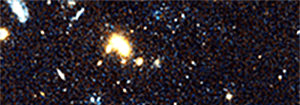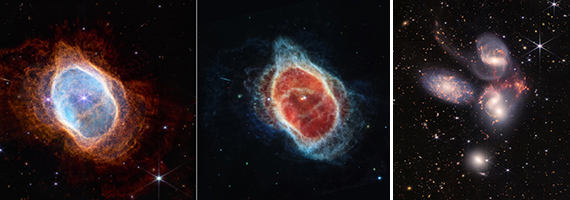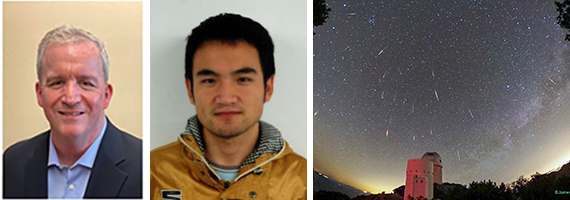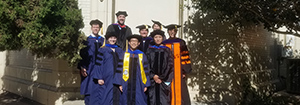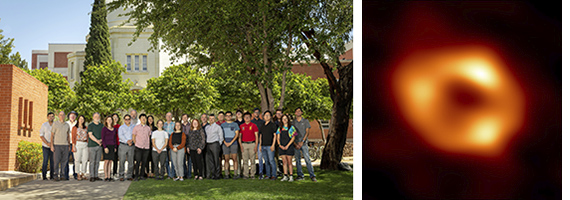At simultaneous press conferences around the world on May 12, including here in Tucson, astronomers have unveiled the first image of the supermassive black hole at the centre of our own Milky Way galaxy. This result provides overwhelming evidence that the object is indeed a black hole and yields valuable clues about the workings of such giants, which are thought to reside at the centre of most galaxies. The image was produced by a global research team called the Event Horizon Telescope (EHT) Collaboration, using observations from a worldwide network of radio telescopes. (The Tucson group is listed towards the bottom here, and there is a link for a larger version of the team photo.)
The image is a long-anticipated look at the massive object that sits at the very centre of our galaxy. Scientists had previously seen stars orbiting around something invisible, compact, and very massive at the centre of the Milky Way. This strongly suggested that this object - known as Sagittarius A* (Sgr A*, pronounced "sadge-ay-star") - is a black hole, and today's image provides the first direct visual evidence of it.
Although we cannot see the black hole itself, because it is completely dark, glowing gas around it reveals a telltale signature: a dark central region (called a 'shadow') surrounded by a bright ring-like structure. The new view captures light bent by the powerful gravity of the black hole, which is four million times more massive than our Sun.
"We were stunned by how well the size of the ring agreed with predictions from Einstein's Theory of General Relativity," said EHT Project Scientist Geoffrey Bower from the Institute of Astronomy and Astrophysics, Academia Sinica, Taipei. "These unprecedented observations have greatly improved our understanding of what happens at the very centre of our galaxy, and offer new insights on how these giant black holes interact with their surroundings." The EHT team's results are being published today in a special issue of The Astrophysical Journal Letters.
Because the black hole is about 27,000 light-years away from Earth, it appears to us to have about the same size in the sky as a donut on the Moon. To image it, the team created the powerful EHT, which linked together eight existing radio observatories across the planet to form a single "Earth-sized" virtual telescope [1]. The EHT observed Sgr A* on multiple nights, collecting data for many hours in a row, similar to using a long exposure time on a camera.
Telescopes used for these April 2017 measurements included the Arizona Radio Observatory SMT telescope on Mt Graham. In addition, Arizona scientists provided the receiver for the South Pole Telescope. (After this observing run, several other telescope were added.)
The breakthrough follows the EHT collaboration's 2019 release of the first image of a black hole, called M87*, at the centre of the more distant Messier 87 galaxy.
The two black holes look remarkably similar, even though our galaxy's black hole is more than a thousand times smaller and less massive than M87*. "We have two completely different types of galaxies and two very different black hole masses, but close to the edge of these black holes they look amazingly similar," says Sera Markoff, Co-Chair of the EHT Science Council and a professor of theoretical astrophysics at the University of Amsterdam, the Netherlands. "This tells us that General Relativity governs these objects up close, and any differences we see further away must be due to differences in the material that surrounds the black holes."
This achievement was considerably more difficult than for M87*, even though Sgr A* is much closer to us. EHT scientist Chi-kwan ('CK') Chan, from Steward Observatory and Department of Astronomy and the Data Science Institute of the University of Arizona, US, explains: "The gas in the vicinity of the black holes moves at the same speed - nearly as fast as light - around both Sgr A* and M87*. But where gas takes days to weeks to orbit the larger M87*, in the much smaller Sgr A* it completes an orbit in mere minutes. This means the brightness and pattern of the gas around Sgr A* was changing rapidly as the EHT Collaboration was observing it - a bit like trying to take a clear picture of a puppy quickly chasing its tail."
The researchers had to develop sophisticated new tools that accounted for the gas movement around Sgr A*. While M87* was an easier, steadier target, with nearly all images looking the same, that was not the case for Sgr A*. The image of the Sgr A* black hole is an average of the different images the team extracted, finally revealing the giant lurking at the centre of our galaxy for the first time.
The effort was made possible through the ingenuity of more than 300 researchers from 80 institutes around the world that together make up the EHT Collaboration. In addition to developing complex tools to overcome the challenges of imaging Sgr A*, the team worked rigorously for five years, using supercomputers to combine and analyse their data, all while compiling an unprecedented library of simulated black holes to compare with the observations.
Scientists are particularly excited to finally have images of two black holes of very different sizes, which offers the opportunity to understand how they compare and contrast. They have also begun to use the new data to test theories and models of how gas behaves around supermassive black holes. This process is not yet fully understood but is thought to play a key role in shaping the formation and evolution of galaxies.
"Now we can study the differences between these two supermassive black holes to gain valuable new clues about how this important process works," said EHT scientist Keiichi Asada from the Institute of Astronomy and Astrophysics, Academia Sinica, Taipei. "We have images for two black holes - one at the large end and one at the small end of supermassive black holes in the Universe - so we can go a lot further in testing how gravity behaves in these extreme environments than ever before."
Progress on the EHT continues: a major observation campaign in March 2022 included more telescopes than ever before. The ongoing expansion of the EHT network and significant technological upgrades will allow scientists to share even more impressive images as well as movies of black holes in the near future.
The EHT consortium consists of 13 stakeholder institutes; the Academia Sinica Institute of Astronomy and Astrophysics, the University of Arizona, the Center for Astrophysics | Harvard & Smithsonian, the University of Chicago, the East Asian Observatory, Goethe-Universitaet Frankfurt, Institut de Radioastronomie Millimetrique, Large Millimeter Telescope, Max Planck Institute for Radio Astronomy, MIT Haystack Observatory, National Astronomical Observatory of Japan, Perimeter Institute for Theoretical Physics, and Radboud University.
The cover photo and a version linked HERE show the Tucson team, from left to right: Shitij Seth - BH PIRE undergraduate student; Gene Lauria - Principal engineer; Tod Lauer - Astronomer, NOIRLab; Rosie Johnson - BH PIRE Project Manager; Martin McColl - Engineer, Arizona Radio Observatories; Feryal Ozel - Professor, Physics and Astronomy, CoS Associate Director of Research, EHT Science Council; Limeng Jiang - BH PIRE undergraduate; Buell Jannuzi - Director, Steward Observatory, Department of Astronomy Head, EHT Management Team; Michael Lambeth - Technician; Anthon Hsu - BH PIRE undergraduate student; Kennedy Sleet - BH PIRE undergraduate student; Soley Hyman - BH PIRE graduate student (Astronomy); David Forbes - Engineer, Arizona Radio Observatories; Amy Lowitz - EHT Scientist; Dan Marrone - Professor, Astronomy, EHT Science Council Member; Alyson Ford - Assistant Director and Assistant Research Professor, Steward Observatory, Manager of Radio Telescopes; Remo Tilanus - Research Professor, Astronomy, EHT Operations Manager; Dimitrios Psaltis - Professor, Physics and Astronomy, former EHT Project Scientist; Trent Tyler - BH PIRE graduate student (Physics); Arash Roshanineshat - BH PIRE graduate student (ECE, Astronomy); Sean Dougall - BH PIRE undergraduate; Tintin Nguyen - BH PIRE undergraduate; Phani Velicheti - BH PIRE undergraduate; Chi-kwan (CK) Chan - Associate Research Professor, Astronomy, EHT Working Group; Gabriele Bozzola - Graduate student (Astronomy); Jasmin Washington - BH PIRE graduate student (Astronomy); Kaushik Satapathy - BH PIRE graduate student (Physics).
Caption for the black hole image: This is the first image of Sagittarius A* (or Sgr A* for short), the supermassive black hole at the centre of our galaxy. It’s the first direct visual evidence of the presence of this black hole. It was captured by the Event Horizon Telescope (EHT), an array which linked together eight existing radio observatories across the planet to form a single "Earth-sized sized" virtual telescope. The telescope is named after the "event horizon", the boundary of the black hole beyond which no light can escape.
Although we cannot see the event horizon itself, because it cannot emit light, glowing gas orbiting around the black hole reveals a telltale signature: a dark central region (called a "shadow") surrounded by a bright ring-like structure. The new view captures light bent by the powerful gravity of the black hole, which is four million times more massive than our Sun. The image of the Sgr A* black hole is an average of the different images the EHT Collaboration has extracted fr om its 2017 observations.
The University of Arizona press release is HERE. The NY Times article is HERE.
This text and these images are from the EHT team.






